
Structural formula
| Business number | 02KK |
|---|---|
| Molecular formula | C9H10O2 |
| Molecular weight | 150.17 |
| label |
Methyl 2-phenylacetate, Methyl ester of phenylacetic acid |
Numbering system
CAS number:101-41-7
MDL number:MFCD00008453
EINECS number:202-940-9
RTECS number:AJ3175000
BRN number:878795
PubChem number:24887319
Physical property data
1. Properties: colorless liquid with a strong sweet and delicate honey aroma, accompanied by a patchouli aroma.
2. Relative density (g/mL, 16℃): 1.066
3. Relative vapor density (g/mL, air=1): Undetermined
4. Melting point (ºC): Undetermined
5. Boiling point (ºC, normal pressure): 216.5
6. Boiling point (ºC, 6.66kpa): 131-132
7. Refractive index (n20D): 1.5075
8. Flash point ( ºC): 96
9. Specific optical rotation (º): Undetermined
10. Autoignition point or ignition temperature (ºC): Undetermined
11. Vapor pressure (mmHg, ºC): Not determined
12. Saturation vapor pressure (kPa, ºC): Not determined
13. Heat of combustion (KJ/mol): Not determined Determined
14. Critical temperature (ºC): Undetermined
15. Critical pressure (KPa): Undetermined
16. Oil and water (octanol/water ) Log value of distribution coefficient: Undetermined
17. Explosion upper limit (%, V/V): Undetermined
18. Explosion lower limit (%, V/V): Undetermined Confirm
19. Solubility: Insoluble in water. Soluble in oil, alcohol and most organic solvents.
Toxicological data
1. Skin/eye irritation: Standard Dresser test: Rabbit skin contact, 500mg/24HREACTION SEVERITY, slight reaction; 2. Acute toxicity: Rat oral LD50: 2550mg/kg; Rabbit skin contact LD50: 2400mg/kg;
Ecological data
This substance is slightly hazardous to water.
Molecular structure data
1. Molar refractive index: 32.20
2. Molar volume (cm3/mol): 142.2
3. Isotonic specific volume (90.2K ): 348.3
4. Surface tension (dyne/cm): 35.9
5. Dielectric constant:
6. Dipole moment (10-24cm3):
7. Polarizability: 16.73
Compute chemical data
1. Reference value for hydrophobic parameter calculation (XlogP): None
2. Number of hydrogen bond donors: 0
3. Number of hydrogen bond acceptors: 2
4. Number of rotatable chemical bondsAmount: 3
5. Number of tautomers: None
6. Topological molecule polar surface area 26.3
7. Number of heavy atoms: 11
8. Surface charge: 0
9. Complexity: 126
10. Number of isotope atoms: 0
11. Determine the atoms Number of stereocenters: 0
12. Uncertain number of stereocenters of atoms: 0
13. Determined number of stereocenters of chemical bonds: 0
14. Uncertain number of stereocenters of chemical bonds: 0
15. Number of covalent bond units: 1
Properties and stability
1. Avoid contact with strong oxidants.
2. Found in flue-cured tobacco leaves, burley tobacco leaves, and oriental tobacco leaves.
3. Naturally found in cocoa, coffee, and strawberries.
Storage method
Store in a cool, ventilated warehouse. Keep away from fire and heat sources. The packaging is sealed. should be kept away from oxidizer, do not store together. Equipped with the appropriate variety and quantity of fire equipment. Suitable materials should be available in the storage area to contain spills.
Synthesis method
1. Obtained from phenylacetonitrile by hydrolysis and esterification. Put methanol into a dry glass-lined reaction pot, stir and cool to below 30°C, add sulfuric acid dropwise, raise the temperature to 90°C after the addition, start adding phenylacetonitrile dropwise, control the temperature at about 95°C, and finish adding in 1.5 hours. After reacting at 95-100°C for 6 hours, cool to below 40°C and add water equivalent to about 0.6 times of the reaction solution to dilute. Leave to separate the acid water, add saturated sodium carbonate solution to neutralize and wash, and discard the water layer. Use anhydrous calcium chloride to dehydrate and fractionate under reduced pressure to obtain methyl phenylacetate with a yield of 80%. Another preparation method is to pass benzyl chloride, anhydrous methanol and water through hydrogen chloride under reflux until saturated, leave it for 2-3 hours, and heat it for 1 hour to produce this product.
2. Tobacco: BU, 14; OR, 26; FC, 9, 18, 40; can be produced by the esterification reaction of phenylacetic acid and methanol.
Purpose
1. Methyl phenylacetate has a honey-like sweetness and a slightly musky aroma. It is often used to prepare floral flavors, such as rose, briar and other flavors, as well as tobacco and soap. This product is also used in organic synthesis and the manufacture of drugs atropine and anisodamine (synthetic method).
2. Can be used in daily fragrance formulas and food flavors.

 微信扫一扫打赏
微信扫一扫打赏

